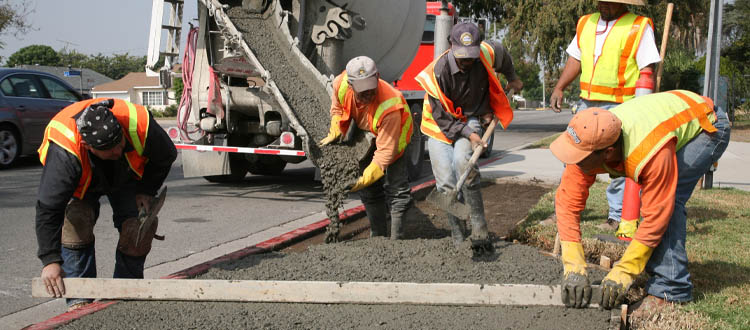
One thing I’m noticing this summer is that the industry looks like it’s returned to its pre-COVID conditions. It’s been on my mind the past few months. Are we back to normal?
When the pandemic hit in 2020, timelines shifted— jobs were put on hold and restrictions were put in place that altered how and when construction projects were completed. But lately, it feels as if the yearly schedule we’re used to is returning, with the industry being busy during the spring and summer months and a little more reserved during the fall and winter like it was prior to 2020.

Here are a few key observations I’ve noticed:
- Contractors have been busy. Over the last few months, many have told me about their large number of in-progress projects and their ever-growing backlogs.
- There has been an uptick in summer employment with contractors hiring additional workers.[1]
With this summer looking like we’re getting back to how things used to be, I think it’s safe to say our usual seasonality is returning.
What is Seasonality and How Has It Changed?
Seasonality refers to a business becoming busier at certain times of the year— like how coat stores perform better in the winter.[2] Before the pandemic, the construction industry’s busy season occurred around the spring and summer months due to stable weather, increased employee availability and a general increase in jobs available.
Then, the COVID-19 pandemic hit. Companies experienced layoffs and projects planned during the summer were on hold and either picked up again during the fall or scrapped altogether. This continued throughout 2021 as the industry hit a significantly low number of project backlogs with a sharp decrease occurring in November of that year.
Slowly, the number of available projects began increasing in December 2021 and January of 2022 causing the busy season for construction to fully shift to the fall and winter seasons. This trend continued throughout 2022 with the number of projects in the summer decreasing before picking up again in the winter, ultimately reaching a high again in February 2023.[3]
Now, as we look back on the first two quarters of 2023, the summer months displayed an influx of projects that are leaning toward a slowdown once again in the fall.[4]
In 2021 and 2022, when the busy season moved to the winter months, it was nearly impossible to hire and retain a qualified workforce as holidays and changing weather prevented timely project completion. But somehow, the industry maintained its busy season from the fall and winter into the spring and summer of this year. If (or should I say when) contractors experience a slow-down again in the fall and winter months of this year, seasonality will have officially shifted back to the summer months.
But the signs of shifting seasonality aren’t just on when projects are happening. It also involves the massive uptick in summer employment as the industry is beginning to slowly gain hiring momentum again.[5]
How is Hiring Gaining Momentum?
After almost three years of inconsistent schedules, contractors are beginning to find steady work. And with steady work, comes the need for more workers.
Over a two-month period leading up to April 2023, the number of workers being hired for jobs has increased by 128,000 across the industry. This growth can be attributed to the change in the busy season reverting back to the summer months, when more seasonal workers are more available (and more willing to work in nicer weather).[6]
With typical seasonality returning, the industry has improved its job open rate— the proportion of job openings or vacant positions within the industry at a given point in time— from 5.5 per 100 positions in 2022 to 4.6 in April 2023.
This low number reflects the demand for new workers in construction and indicates trends in job availability and growth. Altogether, the industry has seen a recent growth of 1.2% which will only be increased further with some of the new hiring trends like increased starting pay and the implementation of new technology— trends that are crucial in attracting a new generation to the industry.
Why the Change in Seasonality Matters.
With the industry normalizing, more projects are becoming available. If construction sustains this seasonality trend, contractors will better know when to look for projects and bid on jobs, increasing their backlogs further. But remember, you have to spend money to make money. Without the right number of workers, you can’t take on more work in the busy summer months.

To manage seasonality and build a sustainable workforce you’ll have to invest in the future. Wages will continue to rise, technology will continue to advance and keeping up with these hiring trends could be the difference between stability and struggle.
Pay attention to when projects are becoming available so you can be ready to win as many as possible when the time comes. Technology can help you effectively support your workforce while still turning a profit. The key is to have all the right tools in place for when the right time— or season— comes along.
[1] Trecek, D. (2023, June 29). Construction labor shortage update for 2023 (and what to do about it). Buildertrend. https://buildertrend.com/blog/construction-labor-shortage/
[2] Eckas, A. (2023, June 14). Managing seasonality: 6 strategies for Growing Your Business Year Round. Knowify. https://www.knowify.com/blog/strategies-for-managing-construction-seasonality/#:~:text=While%20the%20traditional%20construction%20season,experience%20a%20boom%20in%20business.
[3] Bousquin, J. (2021, March 15). 5 charts that summarize a year of COVID-19 in construction. Construction Dive. https://www.constructiondive.com/news/5-charts-that-summarize-a-year-of-covid-19-in-construction/596675/
[4] Caulfield, J. (2023a, July 26). JLL’s 2023 construction outlook foresees growth tempered by cost increases. Building Design + Construction. https://www.bdcnetwork.com/jlls-2023-construction-outlook-foresees-growth-tempered-cost-increases
[5] Can the next generation solve the construction labor crisis?. Jobsite. (2023, June 21). https://www.procore.com/jobsite/can-the-next-generation-solve-the-construction-labor-crisis
[6] Trecek, D. (2023, June 29). Construction labor shortage update for 2023 (and what to do about it). Buildertrend. https://buildertrend.com/blog/construction-labor-shortage/
Share Article
Keep on current news in the construction industry. Subscribe to free eNews!
Our Top 3 YouTube Videos
Learn about our software more in depth with product overviews, demos, and much more!

Our ACA reporting & e-filing services include official 1094-C and 1095-C IRS reporting, optional e-filing (no applying for a TCC code required), mailing to your employees and experienced support to help you.

There are plenty of reasons to make FOUNDATION your choice for job cost accounting and construction management software — just ask our clients!

From job cost accounting software, to construction-specific payroll. Get an overview on your next all-in-one back-office solution.



